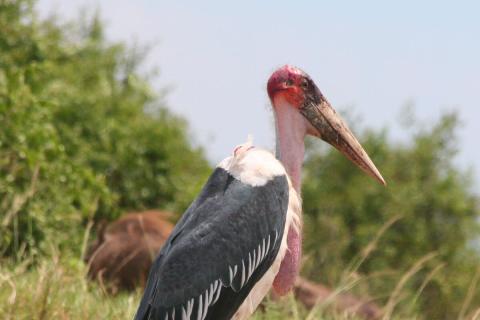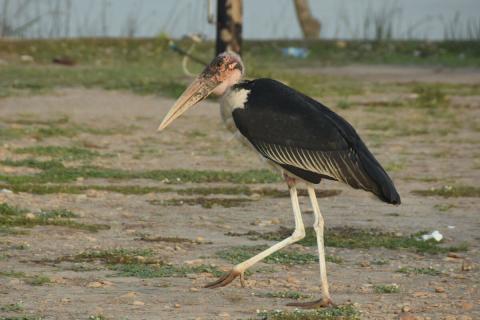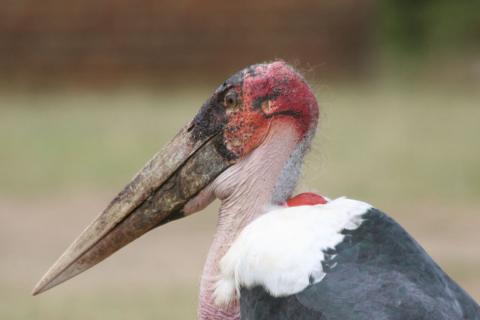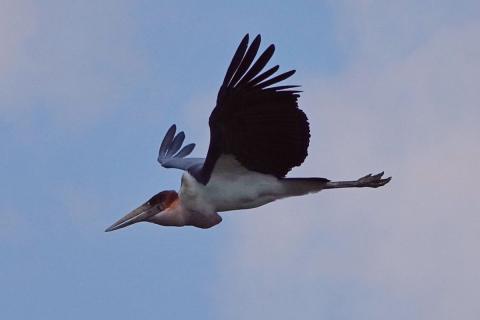Enter the captivating realm of the African savannah, where a remarkable avian inhabitant reigns supreme—the Marabou Stork. With its distinctive bald head, wrinkled neck, and commanding presence, this enigmatic bird captures the imagination. Join us as we unveil the captivating world of the Marabou Stork—a true icon of African avifauna.
In this article, we'll uncover the physical and social traits and adaptations of the marabou stork - including the habitat, diet, social behaviour and so much more.
And while it isn't the bird you think of when it comes to the diversity of the African wild, the marabou stork will surprise you. By the end, you will realize why it is the charismatic undertaker of the African skies.
Facts About Marabou Stork
1. Physical Description
The Marabou Stork is a remarkable bird with distinct features that make it easily recognizable. Standing at an impressive height of up to 5 feet (1.5 meters), it boasts a bald head and neck covered in loose, wrinkled skin.
It has a powerful, charcoal-coloured beak, white plumage with contrasting flight feathers and long slender legs. These features give it a commanding presence whether it is seen standing on the ground or soaring high up in the skies.

2. Size And Weight
The Marabou Stork is an impressive bird in terms of its size and stature. A marabou stork can be as tall as 5 feet (.1.5 meters) which is taller than most of the other big birds.
Despite its imposing height, the Marabou Stork remains relatively lightweight. On average, it weighs around 15 pounds (7 kg). This lightness allows for efficient flight and enables the stork to soar gracefully across the African landscapes.
3. Name Origins
The name "Marabou" is derived from the Arabic word "murābiṭ", which means "one who lives in an isolated place" or "religious recluse". This name likely refers to the bird's habit of nesting in isolated trees or cliffs.
In some cultures, Marabou Storks are associated with death and are viewed as ominous symbols.
4. Close Relatives
Marabou Storks belong to the family Ciconiidae, which includes other species of storks. Some birds closely related to the Marabou Stork within this family include Adjutant storks, Jabiru storks and openbill storks.
These stork species share a common ancestry and exhibit similar characteristics.

5. Habitat
The marabou stork is predominantly found in the different habitats of sub-Saharan Africa. It is a very adaptable bird that can thrive in a range of habitats, showcasing its remarkable versatility.
They are commonly found near rivers, wetlands and lake shores where there is a stable source of food. The diverse aquatic life of fishes, amphibians and crustaceans attract the marabou stork to these wet areas.
In some urban areas, marabou storks are quite common, especially around areas with open and dirty water and this is because of guaranteed scavenging opportunities.
6. Diet
Marabou storks are mostly thought of as scavengers, and this is because they have a very versatile and opportunistic diet which takes advantage of the available food. They mainly eat fish, frogs and other small animals found in the wetlands and lake shores they inhabit. In some cases, they have been observed preying on smaller mammals, birds and reptiles.

As scavengers, marabou storks often feed on dead animals and fish when in the wild. In an urban setting, their scavenging happens in garbage dumps where they can find all kinds of discarded food from the urban dwellers.
Another example of marabou storks being smart and opportunistic scavengers is when there is a wildfire. They go to the side of the fire where the small animals are running to escape the fire. This way, they simply pick them up as easy food.
Marabou storks have long and sharp beaks as well as powerful digestive systems which can allow them to consume a wide variety of food. The digestive system can be thought of in the same way as that of hyenas, or crocodiles - capable of handling almost anything.
As part of the ecosystem, they help clean up the river banks, lake shores and savannah parks of dead animals.
7. Flying
The Marabou Stork is a majestic flyer, known for its graceful and efficient flight. With its expansive wingspan and powerful wingbeats, it soars through the African skies with grace and ease.
Marabou storks can glide in the skies effortlessly by utilizing thermal currents - thus conserving energy during very long flights. This is very helpful, especially for long migratory journeys where a marabou stork can fly for several hours non-stop.
While there is no confirmed figure of how long they can fly, they are such efficient gliders that these flights could take days. In simple terms, marabou storks are great in the sky.

8. Wingspan
The marabou stork's might in the sky is a result of its incredible wings. Its impressive wingspan can reach up to 10.5 feet (3.2 meters) from end to end.
For context, Lebron James' wingspan is around 7 feet (2.1 meters) from end to end. An adult marabou stork's wing span is wider by around 3 feet (1 meter).
The impressive wingspan is a functional adaptation for the marabou stork because it is an important part of helping it easily glide through the skies without expending much energy.
9. Why The White Legs
Marabou storks have white legs that serve several purposes such as thermal regulation, camouflage and courtship. With the white legs, they reflect sunlight to reduce heat absorption, which can be an advantage, particularly in hot African climates.
The white legs are also helpful when the marabou stork is hunting because they easily blend in with the grasses and shallow waters. This assists them to easily aquatic prey more effectively.
Finally, the white legs of Marabou Storks may serve as a visual signal during social interactions and courtship displays. The bright white colouration may attract potential mates and indicate fitness or reproductive readiness.
Overall, the white legs of Marabou Storks are more important than helping them walk.
10. Communication
Marabou Storks communicate through a combination of visual displays, body postures, and vocalizations.
They use elaborate courtship displays such as bill clattering and wing flapping to strengthen pair bonds. Within colonies, they use postures and movements to establish dominance and defend territories.
Cooperative feeding behaviours indicate successful foraging locations. Visual cues, such as head movements and feather displays, express social and emotional states.
While their vocal repertoire is limited, they produce guttural croaks, hisses, and bill-clattering sounds as warning signals or aggressive displays. Communication plays a vital role in maintaining social structure and successful breeding outcomes for Marabou Storks.
11. Reproduction
During the breeding season, male and female pairs engage in elaborate courtship displays to strengthen their bond. The pair then constructs a large nest made of sticks - often in tall trees and near other nests, for safety.
Both male and female storks take turns incubating the eggs, which typically hatch after an incubation period of around 30 days. After hatching, the parents tirelessly care for their young.
The chicks are initially helpless and rely entirely on their parents for food and protection. The adults regurgitate partially digested food to feed the chicks, ensuring their growth and development.
As the young storks mature, they gradually become more independent. Around 3 to 4 months, the juveniles begin to fledge and take to the skies.
Sexual maturity in Marabou Storks is typically reached at around 4 to 5 years of age. At this stage, they are ready to engage in courtship rituals, find a mate, and embark on their reproductive journey.
12. Lifespan
Marabou Storks have a relatively long lifespan compared to many other wild animals in Africa. In the wild, they typically live for around 25 years, although some individuals have been known to reach up to 30 years.
In captivity, Marabou Storks can have even longer lifespans due to the absence of natural predators and access to consistent food and veterinary care. Under optimal conditions, they can live well into their 40s or even 50s.
In comparison, marabou storks to other African wildlife, live longer than animals such as lions, leopards, and other major predators.
Related article: Which African animals live the longest in the wild?
13. Threats
Marabou storks, like many birds face various threats, most of them related to climate change and human activity. The destruction of wetlands, and forests, as well as rapid urbanization, contribute to reducing their habitat, limiting their food sources and contaminating the remaining food.
While they are very adaptable birds, they are not immune to the effects of climate change and the destruction of ecosystems. Conservation of natural environments plays a role in keeping a safe home for the marabou stork.
14. Conservation Status
According to the International Union for Conservation of Nature (IUCN), marabou storks are categorised as Least Concern. This means that their population and numbers are under no direct threat of extinction.
The fact that they are highly adaptable birds and live in a wide array of climates helps.
Final Thoughts
Like most of Africa's less popular wildlife, the marabou stork is truly fascinating. They are captivating and resilient birds that have evolved to thrive in Africa's diverse environments.
On first look, a marabou stork isn't quite as attractive when compared with other birds, but when you look deeper, it is one of the most fascinating birds and a true master of the African wild and skies. They are an important part of the natural ecosystem and play an important role in maintaining ecological balance.
With this article, we hope we have shed better light on the marabou stork to make you appreciate the marabou stork when you see one. It no longer has to be known as the 'undertaker' or a 'dirty scavenger', because it is more fascinating than boring.
Next time you see a marabou stork, we hope you look at it will a different perspective than most people do.
